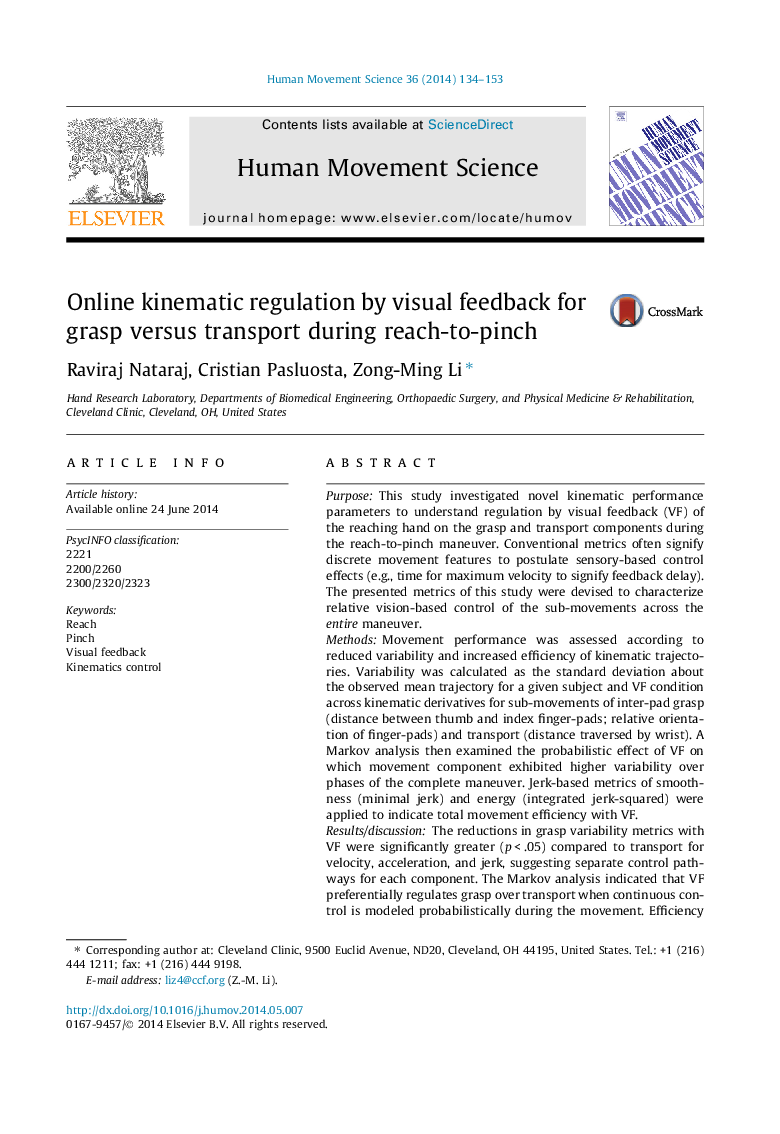| کد مقاله | کد نشریه | سال انتشار | مقاله انگلیسی | نسخه تمام متن |
|---|---|---|---|---|
| 928329 | 1474229 | 2014 | 20 صفحه PDF | دانلود رایگان |
• We examined the effect of visual feedback of the hand on performance of the reach-to-pinch function.
• Visual feedback reduced variability and improved smoothness of the reach-to-pinch movement.
• Visual feedback appears to play a relatively greater role in regulating grasp compared to transport.
• The results of this study suggest that separate control pathways exist for grasp and transport.
PurposeThis study investigated novel kinematic performance parameters to understand regulation by visual feedback (VF) of the reaching hand on the grasp and transport components during the reach-to-pinch maneuver. Conventional metrics often signify discrete movement features to postulate sensory-based control effects (e.g., time for maximum velocity to signify feedback delay). The presented metrics of this study were devised to characterize relative vision-based control of the sub-movements across the entire maneuver.MethodsMovement performance was assessed according to reduced variability and increased efficiency of kinematic trajectories. Variability was calculated as the standard deviation about the observed mean trajectory for a given subject and VF condition across kinematic derivatives for sub-movements of inter-pad grasp (distance between thumb and index finger-pads; relative orientation of finger-pads) and transport (distance traversed by wrist). A Markov analysis then examined the probabilistic effect of VF on which movement component exhibited higher variability over phases of the complete maneuver. Jerk-based metrics of smoothness (minimal jerk) and energy (integrated jerk-squared) were applied to indicate total movement efficiency with VF.Results/discussionThe reductions in grasp variability metrics with VF were significantly greater (p < .05) compared to transport for velocity, acceleration, and jerk, suggesting separate control pathways for each component. The Markov analysis indicated that VF preferentially regulates grasp over transport when continuous control is modeled probabilistically during the movement. Efficiency measures demonstrated VF to be more integral for early motor planning of grasp than transport in producing greater increases in smoothness and trajectory adjustments (i.e., jerk-energy) early compared to late in the movement cycle.ConclusionsThese findings demonstrate the greater regulation by VF on kinematic performance of grasp compared to transport and how particular features of this relativistic control occur continually over the maneuver. Utilizing the advanced performance metrics presented in this study facilitated characterization of VF effects continuously across the entire movement in corroborating the notion of separate control pathways for each component.
Journal: Human Movement Science - Volume 36, August 2014, Pages 134–153
